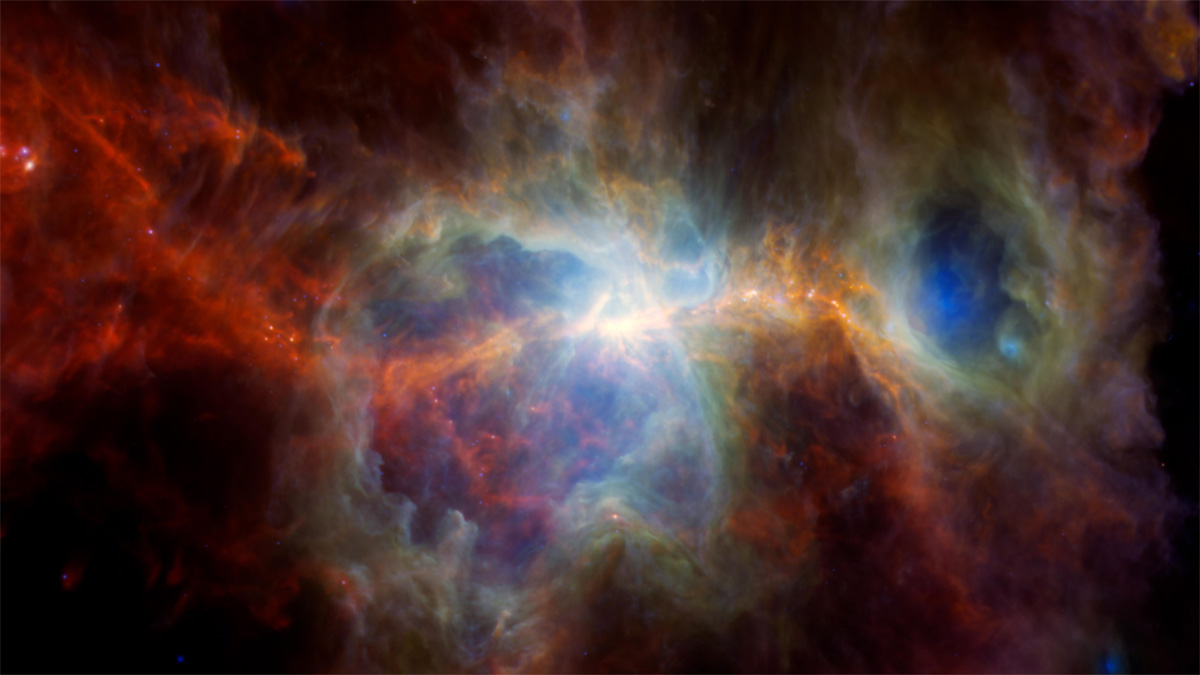Baby stars 'burp' in Orion Nebula after frantic feeding sessions
Staring through thick clouds of gas and dust of the Orion Nebula astronomers were able to see the outbursts erupting from young stars as they gather mass.

Infant stars in the Orion Nebula are emitting bright bursts of radiation as they frantically feed on gas and dust to grow.
The surprisingly frequent feeding frenzies of the newborn stars or 'protostars' in the Orion Nebula, the closest star-forming region to Earth, were revealed by data from NASA's now-retired Spitzer Space Telescope.
Outbursts from stars occur during their earliest stage of development when they are aged around 100,000 years old, and repeat approximately every 400 years, the research reveals. The bright eruptions are clear signs of intense feeding as the infant stars gobble up material from disks of gas and dust that surround them as they accumulate mass.
"When you’re watching star formation, clouds of gas collapse to form a star," research co-author and University of Toledo astronomer, Tom Megeath, said in a statement. "It's literally the process of star creation in real-time."The findings could represent a significant step forward in the understanding of the physics at play during the earliest years of a star's life, including how young stars rapidly gather mass. This period of stellar evolution has been shrouded in mystery as young stars are hidden inside clouds of cool molecular gas and dust that make up the building blocks from which they form.
Within these dense clouds, protostars younger than 100,000 years old (classified as "class 0 protostars") produce outbursts that are tough to observe with ground-based telescopes. The first outburst of this kind was detected almost 100 years ago and since then very few have been sighted.
Between 2004 and 2017, the infrared Spitzer Space Telescope broke this run of bad fortune for astronomers by seeing through the thick clouds of gas and dust to see bright flares from the young stars wrapped within the Orion Nebula. The space telescope's 16-year mission ended in 2020.
Protostar peekaboo
While observing 92 previously known class 0 protostars, the team discovered three outbursts, two of which were previously unknown. This data pointed to a 'burst rate' from the infant stars of around one every 400 years. This is more frequent than the rate of bursts measured from older protostars that are further along in their evolution, the researchers said..
Breaking space news, the latest updates on rocket launches, skywatching events and more!
The team was also able to estimate that these bursts last around 15 years. During the class 0 period, the protostars also accumulated around 50% or more of their total mass, the scientists found. This conclusion was reached by combining Spitzer data with observations made by NASA's space-based Wide-field Infrared Survey Explorer (WISE) and by the retired telescopes the Herschel Space Telescope, and the airborne Stratospheric Observatory for Infrared Astronomy (SOFIA).
"By cosmic standards, stars grow rapidly when they are very young," Megeath said. "It makes sense that these young stars have the most frequent bursts."
Unraveling starbirth mysteries
The findings could also indicate how the consumption of gas and dust from the surroundings of young protesters and the accumulation of mass could go on to influence the formation of planets around stars.
"The disks around them are all raw material for planet formation," Megeath added. "Bursts can actually influence that material."
This influence could extend to triggering the appearance of molecules, grains, and crystals that can stick together to form larger structures — structures like planets. This means that there’s a chance that over 4.5 billion years ago before Earth was formed, the sun was one of these "burping baby stars."
“The sun is a bit bigger than most stars, but there's no reason to think that it didn't undergo bursts,” Megeath said. "It probably did. When we witness the process of star formation, it is a window into what our own solar system was doing 4.6 billion years ago."
The team’s research is published in the Astrophysical Journal Letters.
Follow us on Twitter @Spacedotcom or on Facebook.

Robert Lea is a science journalist in the U.K. whose articles have been published in Physics World, New Scientist, Astronomy Magazine, All About Space, Newsweek and ZME Science. He also writes about science communication for Elsevier and the European Journal of Physics. Rob holds a bachelor of science degree in physics and astronomy from the U.K.’s Open University. Follow him on Twitter @sciencef1rst.
